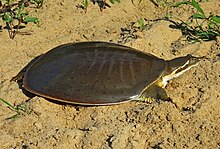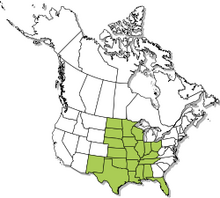The smooth softshell turtle (Apalone mutica) is a species of North American softshell turtle in the family Trionychidae. This freshwater species is endemic to the United States, where it inhabits the Mississippi River system, along with other adjoining waterways that empty into the Gulf of Mexico.
| Smooth softshell turtle | |
|---|---|

| |
| Scientific classification | |
| Domain: | Eukaryota |
| Kingdom: | Animalia |
| Phylum: | Chordata |
| Class: | Reptilia |
| Order: | Testudines |
| Suborder: | Cryptodira |
| Family: | Trionychidae |
| Genus: | Apalone |
| Species: | A. mutica
|
| Binomial name | |
| Apalone mutica | |

| |
| States inhabited by the smooth softshell turtle | |

| |
| Minnesota counties inhabited by the smooth softshell turtle | |
| Synonyms[3] | |
|
Apalone mutica
| |
Geographic range
editA. mutica is native to the United States, where it is distributed throughout the central and south-central states. Its natural geographic range extends from western Pennsylvania in the east to New Mexico in the west, as far north as the Dakotas, and south to the westernmost Florida Panhandle, where it is eventually replaced by the Florida softshell turtle (Apalone ferox).
Smooth softshell turtles are common within the Mississippi River system, from its delta in Louisiana up to North Dakota, as well as in the Colorado River (in Texas), the Brazos, Sabine, Pearl, Alabama and the Conecuh (Escambia) river systems.[1]
Two regional subspecies of Apalone mutica have been identified.
- The midland smooth softshell turtle (A. m. mutica), found throughout the central United States, in and around the Mississippi River.
- The Gulf Coast smooth softshell turtle (A. mutica calvata), found from Louisiana east to the panhandle of Florida.[4]
Habitat
editBoth subspecies of A. mutica are typically found in medium to large, unpolluted fresh waterways, with moderate to fast currents; even in rivers with fast flow, they will swim directly to the sandy bottom and bury themselves, leaving only their nose or eyes exposed as they wait to ambush quickly-passing fish or amphibians. However, they are also found in standing or still bodies of water, like lakes, vernal pools, swamps and marshes. They may also be seen in some canals, reservoirs, or man-made ponds. They prefer water with fine sand or silty, mud bottoms, without heavy boulders, gravel or dense aquatic vegetation. Sandbanks must also be present, as the turtles can be seen sunning themselves for warmth.[1]
-
A. m. mutica basking, Missouri
-
A. m. mutica basking with red-eared sliders, Missouri
Description
editThe smooth softshell turtle has an anapsid skull, a type of skull structure that was present among the earliest groups of prehistoric reptiles (and retained by turtles today). Primarily, an anapsid skull lacks openings behind the orbits (as opposed to the synapsid or therapsid skull).[5]
The smooth softshell turtle, as with all softshells, has a smooth, fairly soft, flexible, leather-like carapace that is covered by "skin", as opposed to the hard scutes commonly associated with most turtle species.[6] The plastron is light white or gray, with no notable markings (other than occasional spotting), and its internal anatomy (bones, some organs) may be visible, as it lacks the typically hard shells of other aquatic turtles.[7] It has a tubular snout with round nostrils, sometimes compared to a "pig" nose.[8]
Sexual dimorphism
editThere is sexual dimorphism between females and males of A. mutica as females are larger than males. A female has a carapace length of 16.5–35.6 cm (6.5–14.0 in) compared to a carapace length of 11.4–17.8 cm (4.5–7.0 in) for males.[6] Additionally, the female smooth softshell turtle is usually brown or olive-colored with irregular dark brown blotches, while the carapace of males and juveniles is a brown or grayish color with dark dots or dashes.[1] Sexual dimorphism is also apparent in the size of the tails and claws. Males have thicker tails than females, but females have longer hind claws than males.[8]
Similar species
editThe smooth softshell turtle may be easily confused with the spiny softshell turtle (Apalone spinifera), as the differences between the two species are subtle. The spiny softshell turtle has a rough carapace with spines along the front edge while, as the name implies, the smooth softshell turtle lacks such spines.[9] Additionally, the white chin and throat of the smooth softshell are unmarked, compared to the splotchy chin and throat of the spiny softshell.[9] A. mutica is the only species of North American softshell with round nostrils; all other species have ridges on the nasal septum which make the nostrils C-shaped.[10]
Diet
editThe smooth softshell turtle is mostly carnivorous, eating aquatic insects, crayfish, fish and amphibians.[11] Although primarily carnivorous, it sometimes resorts to eating vegetation such as algae, vegetables, fruits, and nuts.[7]
Reproduction
editBreeding of the smooth softshell turtle occurs from April to June. The mating system utilized by these turtles is polygyny, meaning that males will mate with more than one female. Males actively seek out females by approaching other adults. If the other party is male or a non-receptive female, aggression may be displayed. However, if the other party is a receptive female, she remains passive to the advancements of the males. Copulation usually occurs in deep pools as the male mounts the female.[8] The nesting period is usually from May to July as females only lay eggs once a year.[7] During this period, adult females of A. mutica lay clutches of 3 to 28 eggs not more than 100 m (330 ft) from water in sandy areas.[12] Eggs generally hatch 8 to 12 weeks later with the highest frequency of hatching being between August and September. Hatchlings average a weight of 5.4 g (0.19 oz) and have a carapace length of 4 cm (1.6 in). Male smooth softshell turtles become sexually mature during their fourth year and females become sexually mature during their ninth year.[4]
Female turtles offer prenatal care for their offspring. They produce high levels of non-polar lipids that provide energy for their growing embryos.[13] This energy is more than enough to keep the embryos alive. The high concentration of lipids also offer an advantage at birth as it acts as a food source until they hatchlings become mature enough to commence feeding. This type of care is also known as parental investment in embryogenesis. However, after hatching no physical parental care is given.[13]
Life history
editThe smooth softshell turtle is the most aquatic of the softshell turtles as it is often referred to as a "swimmer".[14] It is able to stay underwater for extended periods of time due to its long neck and tubular snout. It often buries itself in the sand substrate at the bottom of a river or pool just deep enough so that its snout barely reaches the surface.[7] Additionally, the skin covering the shell allows for a high rate of gas exchange. This enables the turtle to stay submerged for a long period of time. In this position, it often waits for prey to pass and utilizes its long neck to capture the prey.[6]
The smooth softshell turtle hibernates in the months of October to March. It hibernates by burying itself in substrate underwater. After emerging from hibernation, it is often found on land basking in the sun. Given that its shell is a soft shell, it is unable to stay in the sun for extended periods of time.[14] When basking, it is wary of its surroundings, and if any threat presents itself, it is quick to abandon its basking site to seek safety. Its agility on land and water makes it a difficult prey item for predators such as raccoons, humans, alligators and snapping turtles.[8] It seeks shelter from these threats by diving and concealing itself in mud.[8]
Conservation status
editCurrently, the smooth softshell turtle is considered a species of least conservation concern. However, the species is still facing some wide-ranged threats.[1] These threats include habitat degradation, harvesting for food, and an increase in human disturbances at nesting sites. Additionally, due to its skin's high rate of gas exchange, it is very susceptible to polluted waters.[6] As a result of all of these factors, the smooth softshell turtle has been listed as a species of special concern in Minnesota and Wisconsin.[6][15]
Subspecies
editTwo subspecies are recognized, including the nominotypical subspecies.[16]
- Apalone mutica calvata (Webb, 1959)
- Apalone mutica mutica (Lesueur, 1827)
Nota bene: A trinomial authority in parentheses indicates that the subspecies was originally described in a genus other than Apalone.
Sympatric species
editApalone mutica is sympatric with the spiny softshell turtle (Apalone spinifera) over much of its range.[17]
References
edit- ^ a b c d e van Dijk, P.P. (2016) [errata version of 2011 assessment]. "Apalone mutica". IUCN Red List of Threatened Species. 2011: e.T165596A97398190. doi:10.2305/IUCN.UK.2011-1.RLTS.T165596A6064798.en. Retrieved 15 January 2020.
- ^ "Apalone mutica ". Integrated Taxonomic Information System (ITIS). ITIS.gov
- ^ Fritz, Uwe; Havaš, Peter (2007). "Checklist of Chelonians of the World". Vertebrate Zoology. 57 (2): 306. doi:10.3897/vz.57.e30895. ISSN 1864-5755. S2CID 87809001.
- ^ a b "Apalone mutica (Smooth Softshelled Turtle)". Animal Diversity Web.
- ^ Downs, Floyd; Grinnell, Jon (2017). Vertebrate Zoology Biology 242 Laboratory Instructions. St. Peter, Minnesota: Gustavus Adolphus College.
- ^ a b c d e "Apalone mutica : Smooth Softshell | Rare Species Guide".
- ^ a b c d "Apalone mutica (Smooth Softshelled Turtle)". Animal Diversity Web.
- ^ a b c d e Ernst C, Lovich J (2009). Turtles of the United States and Canada, Second Edition. Baltimore, Maryland: The Johns Hopkins University Press. 840 pp. ISBN 978-0801891212.
- ^ a b Oldfield, Barney; Moriarty, John J. (1994). Amphibians and Reptiles Native to Minnesota. Minneapolis, Minnesota: University of Minnesota Press. 237 pp. ISBN 978-0816623846.
- ^ Powell R, Conant R, Collins JT (2016). Peterson Field Guide to Reptiles and Amphibians of Eastern and Central North America, Fourth Edition. Boston and New York: Houghton Mifflin Harcourt. xiv + 494 pp. ISBN 978-0-544-12997-9. (Apolone mutica, p. 231 + Plates 20, 22 + Figure 85 on p. 186).
- ^ "Apalone mutica mutica ". Ohio Department of Natural Resources. ohiodnr.gov
- ^ DNr.wi.gov Archived June 16, 2010, at the Wayback Machine
- ^ a b Nagle, Roy D., et al. (2003). "Parental investment, embryo growth, and hatchling lipid reserves in softshell turtles (Apalone mutica) from Arkansas." Herpetologica 59 (2): 145-154.
- ^ a b "Smooth Softshell Turtle - Encyclopedia of Life".
- ^ "Smooth Softshell (Apalone mutica)". dnr.wi.gov. Retrieved 2017-10-05.
- ^ Species Apalone mutica at The Reptile Database www.reptile-database.org.
- ^ Williams, Thomas A.; Christiansen, James L. (1981). "The Niches of Two Sympatric Turtles, Trionyx muticus and Trionyx spiniferus, in Iowa". Journal of Herpetology 15 (3): 303-308. JSTOR.org
Further reading
edit- Behler JL, King FW (1979). The Audubon Society Field Guide to North American Reptiles and Amphibians. New York: Alfred A. Knopf. 743 pp. ISBN 0-394-50824-6. (Trionyx muticus, pp. 484–485 + Plates 268, 269).
- Boulenger GA (1889). Catalogue of the Chelonians, Rhynchocephalians, and Crocodiles in the British Museum (Natural History). New Edition. London: Trustees of the British Museum (Natural History). (Taylor and Francis, printers). x + 311 pp. + Plates I-V. (Trionyx muticus, pp. 260–262, Figure 68).
- Lesueur CA (1827). "Note sur deux espèces de tortues, du genre Trionyx de M[onsieur]. Geoffroy-Saint-Hilaire ". Mémoires du Muséum d'Histoire Naturelle, Paris 15: 257-268 + Plates 6–7. (Trionyx muticus, new species, pp. 263–266 + Plate 7). (in French).
- Smith HM, Brodie ED Jr (1982). Reptiles of North America: A Guide to Field Identification. New York: Golden Press. 240 pp. ISBN 0-307-13666-3. (Trionyx muticus, pp. 32–33).
- Stejneger L, Barbour T (1917). A Check List of North American Amphibians and Reptiles. Cambridge, Massachusetts: Harvard University Press. 125 pp. (Amyda mutica, p. 124).
- Webb RG (1959). "Description of a New Softshell Turtle From the Southeastern United States". University of Kansas Publications, Museum of Natural History 11 (9): 517–525. (Trionyx muticus calvatus, new subspecies).
